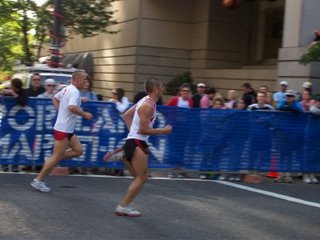 I took this photo from Les Smith's VIP tent during the Portland Marathon. Albert Lam (right) of Oregon City is mere seconds from finishing with a time of 2:50:41. The pacer on the left is one of Albert's Red Lizard teammates.
I took this photo from Les Smith's VIP tent during the Portland Marathon. Albert Lam (right) of Oregon City is mere seconds from finishing with a time of 2:50:41. The pacer on the left is one of Albert's Red Lizard teammates.The following is an excerpt from an article I wrote for the Oregon Distance Runner on attending the 2006 Portland Marathon Event Directors' College:
We discussed all things related to race directing, including training. One comment from Joe Henderson, who currently trains a group in Eugene, is that marathon race directors should create a training program for their event, if they don’t already have one. “A quarter of all participants are part of some training program,” he said. “Create your own runners.“
We’ve already seen a rise in marathon training programs. As the definition of the runner has changed, more people are willing to run a race without the negativity that used to accompany a slow finish time. “They’re, ‘I’m slow, I know, get over it,’” John Bingham said. “They’re militant, in some ways, about it.” The average marathon finish time has risen from 3:30 to 4:30, partly because of the popularity of training programs that allow participants to get involved who don’t necessarily consider themselves runners.
Here in Portland, we have Portland Fit / Vancouver Fit who train for the Helvetia Half Marathon, Portland Marathon and Hood To Coast, in addition to the official Portland Marathon Training Clinic, who train for the Portland Marathon and the Shamrock Run. Plus, there are several charity-based groups such as Team In Training that provide training programs for marathons, half marathons, cycling, and the triathlon.
The larger programs are popular, but don’t discount the smaller groups. When you have a group that’s 1000 people or more, it’s hard to keep track of what they’re doing and how they’re progressing. Even Portland Fit, who boasts a group of 1600 people for the 2006 Portland Marathon, are actually made up of several smaller groups that are broken down by running and walking pace. Joe Henderson considers the perfect number for a training group to be around 30, which is the number of runners in his Eugene program that trained for the 2006 Portland Marathon. He commented that many of his nationally known colleagues, with the exception of Jeff Galloway, don’t get the chance to experience their own training programs on a person-to-person basis and see them play out.
Also, remember that charity groups are great, but runners have to train for themselves first, and the charity second. Jeff Galloway pointed out that people who get involved for a cause may lose weight or get in shape for that event, but they’ll not make life-altering changes toward fitness unless they’re doing it for themselves. He recognized the efforts of Prevention Magazine and the recent Kaizer Permanente ads that support the notion that people have to take responsibility for their heath, and that a training program that is easy for them to join and relatively easy to complete will help them transform their running into a healthier lifestyle.
As you can read, I touched on several things related to training programs and race directing that were discussed during the marathon conference. I wrapped up the article with a plug for the training program that I started through the Oregon Road Runners Club for our Vernonia Half Marathon, as the number of marathon programs that target those on the couch far outweigh beginner programs of shorter distances.
What do you think about the increasing number of (slower) marathoners? Is this supposed to be a race that anyone can do? Do programs that target beginners and take an "easy" approach to training really have long-term benefits for those who complete the program? And, what is the percentage of beginners that start these programs that actually finish the marathon?
The positive spin on more people signing up for the marathon is that it improves public health and fitness, as well as give more publicity to the sport of running. Has this happened yet, or are we to see more dramatic results in years to come?
Bryan Westby
No comments:
Post a Comment